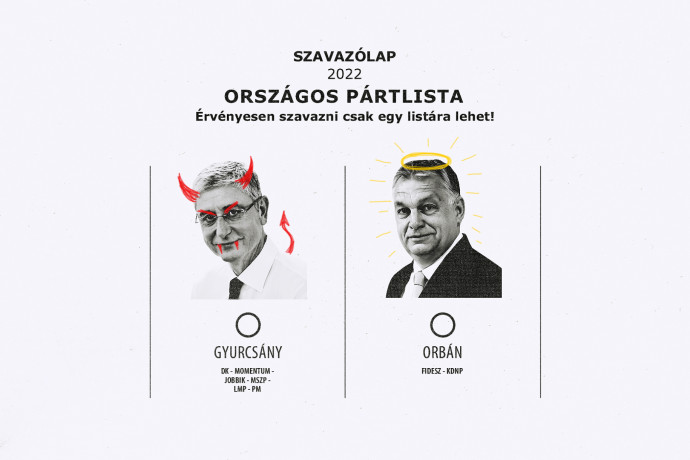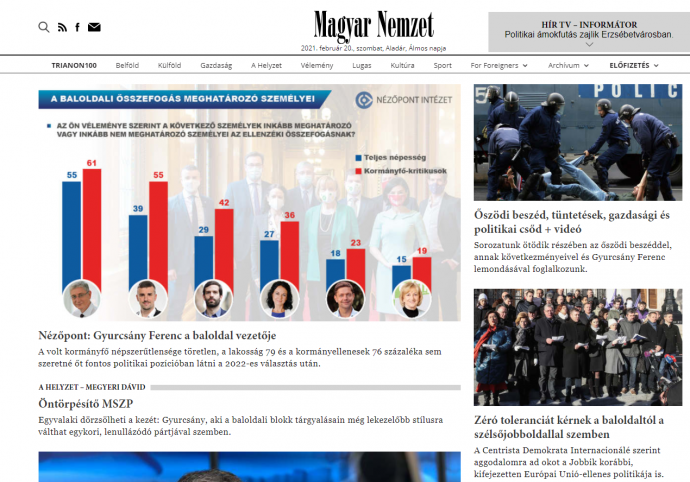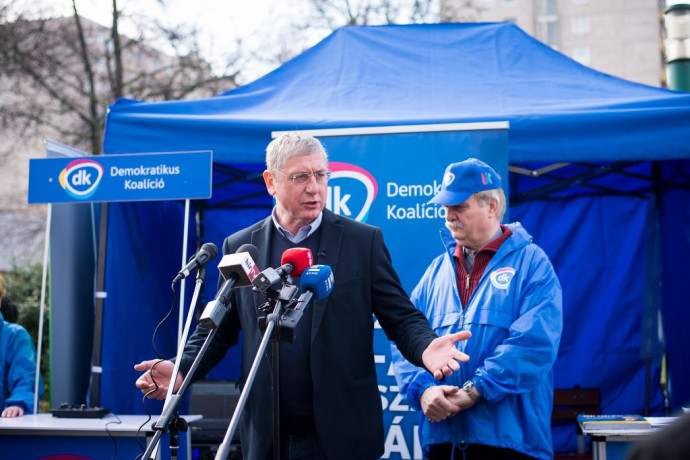
Fidesz could be at a disadvantage if the opposition manages to present the 2022 election as a referendum on Orbán. So Fidesz needs to frame the choice differently. Translated by Charles Hebbert.
The Fidesz plan is to make the election not a choice of Orbán or no Orbán, but of Orbán or Gyurcsány. Ferenc Gyurcsány, the leader of the opposition Democratic Coalition (DK) party, who has been a controversial figure in Hungarian politics for many years. In 2006 as prime minister of the Socialist-led government he gave a speech to a party meeting about how they had “lied, lied and lied” to the electorate by not divulging the hard realities of the Hungarian economy. The speech was leaked and Fidesz used it to whip up feeling against the government and subsequently to win the 2010 election.
To “Gyurcsányise” is a term of abuse, to link anything bad, however irrelevant, to Gyurcsány, just as the Hungarian government has long been doing with George Soros. It has worked before, but will it work now, when not even all Fidesz supporters think that Gyurcsány is the leader of the opposition?
Does Fidesz really want Gyurcsány to disappear?
“It gives us no pleasure, Mr Gyurcsány, to Gyurcsányise everything and everybody. What would give us pleasure is if you were to disappear from Hungarian public life."
Máté Kocsis, the Fidesz parliamentary leader said it at the first spring session. He was speaking in response to Gyurcsany’s comment that Fidesz leaders seem to derive a curious pleasure from all this Gyurcsány-ising. While Kocsis might claim that they want Gyurcsány to disappear, government communications of the past few days suggest quite the opposite.
For recently Fidesz has begun to turbo-charge its Gurcsányising, which seems likely to be one of the party’s key communication weapons in the run-up to 2022.
Attacks on Gyurcsány are nothing new for Fidesz, but the series of five articles that the government daily Magyar Nemzet began running on 8 February this year still came as a surprise. Entitled “Ferenc Gyurcsány and what is behind him”, the paper sought the show to how Gyurcsány had become “the most influential figure in the enforced coalition of the left wing”, which is Fidesz shorthand for the leader of the opposition.
The purpose of the articles was far from obvious — to the extent that the Press Club (Sajtóklub) programme on the Hír TV news channel had to spell it out it to the government-supporting audience.
László Néző, the editor-in-chief of the Mediaworks media conglomerate, said that it was very important to write about Gyurcsány and to “make people aware” that a vote for any opposition candidate was a vote for Gyurcsány.
“It doesn’t matter who is on the poster, who is the candidate or who is standing to be prime minister, or how they unite or not, anyone voting for the opposition in 2022 is voting for Ferenc Gyurcsány. This is the information that the articles are imparting,” said László Néző.
Ottó Gajdics, a regular commentator on the programme, added that it is critically important for everyone to know Gyurcsány’s history.
The new Soros
The articles about Gyurcsány’s life were shared right across the government-supporting media, including public television. Fidesz politicians joined in and, looking at February as a whole, you needed a magnifying glass to find statement from a government politician that isn’t somehow connected to Gyurcsány.
- Máté Kocsis said there was no need to identify the left wing with Gyurcsány: Gyurcsány is himself the left wing.
- Tamás Menczer, a government minister, said Momentum is Gyurcsány’s satellite party, and its spokesman is Gyurcsány’s man.
- István Hollik, Fidesz’s director of communications, said that Gyurcsány and the left wing have taken away young people’s future.
The Fidesz strategy is clear. Just as it tried to paint everyone in the opposition as a Soros man in the run-up to the 2018 elections, now it is doing the same with Gyurcsány. The timing is crucial here. The complex Hungarian electoral system combines single-seat constituencies with proportional representation lists. Recent changes in the regulations compelled the larger opposition parties to announce that in the coming election they will form a joint list — and Gyurcsány will be on that list.

In 2018 such a move would have been out of the question, as that would have meant trying to link the far-right Jobbik party and its leader Gábor Vona with Gyurcsány. Furthermore, the joint list will offer a firmer ground for Fidesz to construct its Gyurcsány narrative for the election campaign.
The party’s own research shows that the choice of the Orbán or not Orbán would be far less favourable for Fidesz than the choice of Orbán or Gyurcsány.
This makes the Gyurcsány the central plank of all Fidesz communications about the opposition, and the extent to which this is effective will be critical in the election. Many opinion polls in recent months have indicated that if an election were held immediately and if the opposition were able to unite (this is still quite a long way off), then they could yet defeat Fidesz.
Read our further analysis here…
Fidesz is in a tricky position
So the aim of this “Gyurcsány strategy” is both to prevent the opposition making Orbán the focus of the election, and to personify the opposition with an identifiable face they can target — at present the opposition is a “many-headed dragon”.
Analysts close to Fidesz believe that Gyurcsány is clearly the best choice for this role. They say that Gyurcsány is by far the best known opposition politician (only he can match Orbán voter recognition levels of more than 90 percent) — he is the only opposition leader who has been in government. Most polls also say he scores the highest disapproval rates.
However, to treat as equal the two men’s influence on their respective political wings is problematic.
Orbán’s leading role is indisputable: for almost 25 years, bar a few wobbles, he has been the leader of the right wing. He has been in government since 2010, almost the whole time with a dominating two thirds majority. He can have the final say on every important political, economic or cultural question.
In comparison, Gyurcsány’s party, the DK, came within a few thousand votes of missing out on parliamentary representation at all in 2018; true, since then the DK has recovered and since the 2019 European elections, according to most polls, has been the second strongest party behind Fidesz.

Fidesz sources believe this offers a realistic basis for their new strategy. They say that the DK is the biggest, most united and most organised party among the opposition, and has the most resources. They also say Gyurcsány’s recent appearances and statements confirm his clear political ambitions.
Meanwhile Gyurcsány and the other opposition party leaders say that he is just one among equals and has no leading role in their collaboration.
It runs against the Fidesz narrative that the six opposition parties are giving up their identities not to give Gyurcsány a leg-up into power again, but to topple Orbán. They are working together to fulfil the demand of anti-Orbán voters — you could say the broad will of the people has forced the opposition to work together purely to bring Orbán down.
Anti-Orbán feeling is mobilising
Government sources thought this strategy would work for Fidesz since Gyurcsány’s unpopularity and high disapproval rating will prove a barrier for the opposition. Opinion polls haven’t supported this view. If respondents are given a simple choice between the government and the opposition, both sides gain more support than if the opposition parties are listed separately — but the opposition gains more. This simplified choice reduces the question to Orbán or not Orbán, which, as we have said, is what Fidesz wants to avoid. It may be that voters broadly hostile to the government who don’t support any particular party are happier to vote for a joint list.
At the same time Fidesz sources say that according to the latest surveys more than half the population is satisfied with Orbán’s work and his popularity is higher than that of his party. So they say placing him at the centre of the campaign increases Fidesz’s chances.
There was general agreement among pollsters that if the choice was between a Gyurcsány list and an Orbán list, the opposition would lose the 5-6 percent benefit that a unified list brings.
The fact that Gyurcsány’s name will indeed be on the opposition list does add credibility to the government’s talk about a “Gyurcsány list”. However, he is unlikely to head the list, he won’t be the candidate for prime minister and he has stated that if the opposition were to win, he won’t be a member of a coalition government. For voters inclined toward the opposition it is by no means clear why Gyurcsány would be the leader of the opposition.
Even research by the Nézőpont Institute, which is close to the government, indicates that there is no consensus among the electorate over the role of Gyurcsány within the opposition. In its poll at the beginning of February 61 percent of those critical of the government thought that Gyurcsány played a leading role in the unifying the opposition; 55 percent said Péter Jakab, the Jobbik leader, and 42 percent said András Fekete-Győr, the Momentum leader.

Nézőpont found that 45 percent of those questioned thought Gyurcsány was the leading politician of the opposition. Of these, 54 percent supported Orbán and 38 percent were critical of the prime minister. The poll found that 23 percent thought that Gyurcsány had no role in the opposition’s collaboration, while 32 percent said they did not know or did not answer.
Have voters got over the Gyurcsány question?
Fidesz believes that since Gyurcsány’s disapproval rating is so high (in total around 20 percent of voters would like to see him hold an important political position), the DK leader also is divisive among opposition voters. One Fidesz source said that “roughly half of opposition voters feel uncomfortable about him” so that they have not all got over the Gyurcsány dilemma.
The results of the 2019 local elections suggest otherwise: in half of the larger cities, where the opposition joined forces it defeated Fidesz candidates.
However Fidesz analysts say this can’t be used to draw conclusions about the 2022 general elections. Firstly, the turn-out for the local elections was about 50 percent — which they interpret as meaning that only committed opposition supporters voted, those who were already over that dilemma. In general elections the turn-out is closer to 70 percent, and those who are not so committed may still be wavering on the matter.
Secondly, the prime minister hardly took part in the local election campaign so the “Orbán factor” did not come into play. In the 2022 elections “it will be almost all about him,” said one source.
Fidesz hopes that by playing the Gyurcsány card it can both take the wheels off the opposition campaign and undermine its candidate for prime minister, whoever that may be, and efficiently mobilise its own voters. Anti-Gyurcsány feeling has been central to Fidesz’s identity since 2006.
The question may arise whether starting to Gyurcsányise in such a turbocharged manner so early in the campaign might not backfire by next year if it becomes boring. Experience suggests, however, that if done cleverly, this won’t be a problem — you only have to look at the continuous campaigns against migrants and against George Soros.